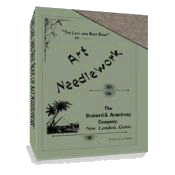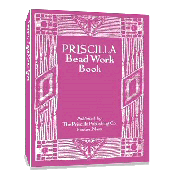Simple Christmas Gifts of 1896
These simple Christmas gifts were suggestions given to ladies in a December issue of Harper's Bazaar, 1896, to make for those on their Christmas list.
A Handy Receptacle
A pretty novelty is a receptacle for newspapers, or odds and ends of any sort. It is in the form of a closed parasol, and is hung up by its handle on the door or the wall. To make this article, cut a large circle, one foot and a half in diameter, from any chosen material — fancy silk is handsome, but cretonne more durable. A delicate yellow flowered in lilacs is attractive, with a lining of purple or mauve silk or Silesia.
Baste the material and its lining together, and bind the entire edge with mauve satin or gros-grain ribbon an inch wide. In the exact central point of the circle thus made cut a hole large enough for the handle to pass through at its point, and bind this opening with ribbon. The handle of a worn-out parasol can be used, or, if preferred, a new one can be bought at any shop where parasols are covered and repaired. Place the point of the stick through the opening and draw up the material, making the flaps all equal, which can be accomplished by previously folding the circle into equal parts, and marking them on the edge by a little thread, to be pulled out when the parasol is finished.
Fasten the flaps to the handle, and conceal the fastenings by a bow of mauve or purple ribbon two or three inches wide tied around the handle. Suspend by a ribbon tied at the top in a bow. This parasol may serve as a shoe-bag as well as a paper holder.
Tea Table Cover
For any one fond of embroidering, a handsome piece of work is a cover for a small tea table, the coarse linen to be used coming in all the art shades so effect — delicate rose-color, blue, yellow, and other hues. The cloth has an inch-wide hem all around it, finished with a narrow line of drawn-work, and in each corner is a design of large Scotch thistles, asters, or any preferred pattern, done in white filo-floss, the design extending on two sides with a cluster of the chosen flowers, thus making the work quite elaborate.
A Glass or Goblet Cover
A simple and useful little trifle is a cover for a goblet or glass, and is very serviceable in a household containing an invalid or young child, where a glass with medicine, milk or other beverage is kept standing ready for use. A circle large enough to cover an ordinary glass tumbler is cut form white card-board. A narrow strip of the same is sewed by fine overhand stitch around the circle, so that the strip turns down, making a neat little cover that will fit over the tumbler. A round piece is then crocheted from crochet silk, any color like — white, pink, or blue — and when the right size, it is finished around the edge with a fancy stitch of shell-work, or any other small one. This crochet piece is then fitted over the little cardboard cover, and sewed into place with silk of the right color, making an ornamental bit of handiwork.
Ball of Cord Cover
Another similar small article is a knitted or crocheted cover for a ball of cord. A ball of scarlet or pink cord, such as is used for any feminine householder in tying up small parcels, is placed inside a cover of kitted or crocheted silk of the same shade, one end of the cord hanging out, to be with in reach. The ball thus enclosed is suspended form any convenient hook or projection by narrow ribbons matching the color used.
The same article, made differently, and even prettier than the above, is formed of little brass rings concealed by button-holing them around with silk twist, and then sewing them together about the ball of colored cord.
Children’s Toys
In a family where there are children, home-made dolls and toys of various kinds are always most welcome presents, many little folks being as happy over a black Dinah or a baby elephant as with a really expensive plaything. These are particularly acceptable out in the country, where there is found so little variety in any direction. It is an easy matter to fashion them, and only requires a little ingenuity in first drawing the pattern before cutting the material. Some regular houses where fashion designs are done also publish patterns for dolls, animals, and other toys.
Dolls are best cut from linen or strong muslin, the faces hand-painted, the hair made from floss, silk or thread, or even flax. A whole family of such creations would delight the hearts of any children, and might consist of the parent dolls, one or two boys and girls, and a baby in long clothes, with a colored nurse in true Southern rig of gay skirt and long checked apron, kerchief folded over her breast, and a bright bandanna turban on her head.
Animals make some pretensions to naturalness if cut from Canton flannel or rough wooly cloth. Black or white beads serve for eyes, the other features simulated by stitches of black, white, or red cotton, or bits of worsted sewed on.
A person with any taste or experience in wood-turning or wood-carving can manufacture toys of all kinds — chairs, table, bedsteads, and even a doll’s house.
The art paper dolls are really beautiful, but they necessitate some knowledge of designing and water-colors. They are cut from card-board or heavy etching-paper, and painted to represent very elegant young gentlemen, pretty ladies, and dear little children. Their various costumes are adjustable, and are suitable for all different occasions, being sometimes original in design, sometimes copied from a fashion publication. Although these choice art creations require a practical hand, simple and unpretentious dolls can be made by any one with a little skill in manipulating scissors and paint-box.
Flower Pot Cover
Something novel is the silk bag used as a cover to draw up over a flower-pot. It is made by covering two circular pieces of strong cardboard with cretonne or silesa, having them the size of the bottom of the flower-pot. It is not well to have them of silk to match the bag, as the moisture is apt to come through and spot them. Next take two strips of silk the depth of the flower-pot, and a couple of inches more to allow for the frill. The outer silk should be flowered or fancy, the inner lining of some plain color that harmonizes with it. Join the ends of each strip first, then sew the tow together. Gather top and bottom, leaving the rill.
Use a narrow ribbon as a gathering sting, tying the ends in a double bow when drawn up tight. Sew the bottom of the gathered silk around the circle of covered card-board, the two pieces having been already neatly overhanded together. Now draw the bag up over the flower-pot, which would stand firm on the circle, pull the ribbon until the bag fits rightly around the top of the flower-pot (the frill extending beyond), tie the ends of the ribbon, and you have a unique ornament for your window-ledge or small table, it being assumed that the pot contains a plant.
A Dainty Needle-book
A dainty needle-book and pin-cushion combined is formed of two circular pieces of card-board covered with silk — one plain heliotrope, and the other yellow hand-painted in violets — these two overhanded carefully together. A duplicate is next made, but reversing the colors, the lining plain yellow the outside heliotrope decorated with yellow pansies. Thee two completed circles are tied together with a knot of heliotrope ribbon, and each one is stuck full of pins of different sizes. But before tying together, each circle has sewed on the inner side a little silk receptacle large enough to hold two papers of needles. When finished, the needle-book is hung up by a loop of heliotrope ribbon, and is quite ornamental.
Return to top of Simple Christmas Gifts of 1896 page.
Return to Victorian Christmas page.
The Last and Best Book of Art Needlework
Over 100 pages of authentic Victorian instructions and patterns from 1895!
FREE
Beeton's Book Of Needlework

433 pages!
Sign up for VEAC! Everything you wanted to know about Victorian embroidery, needlework, crafts and more!
Priscilla Bead Work Book
Make Beautiful Victorian Beaded Purses, Jewelry & Accessories - Starting
TODAY!



